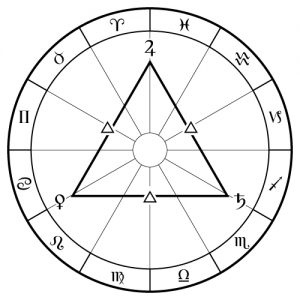A Grand Trine is a planetary aspect pattern that occurs when three planets in a chart trine each other (120°), forming an equilateral triangle. In a Grand Trine aspect pattern, all three planets are in the same triplicity, resulting in an emphasis on that element. 
Trines are supportive aspects that are often experienced as subjectively positive by the native. Key to understanding the Grand Trine is looking at the three houses in the chart that house the Grand Trine planets, as well as the rulers of those houses. Natives with Grand Trines often feel quite comfortable with those areas of their life emphasized by the aspect pattern, and may even take those areas for granted or fail to do the work necessary to bear fruit in these areas. It can be difficult for natives with this aspect pattern to rise to the challenges and growth opportunities presented in other areas of the chart, rather than rest easy in the Grand Trine’s more comfortable territory.
Natives with a Grand Fire Trine are often confident, spontaneous, and have significant vitality and energy. Grand Earth Trine natives are secure and stable, with significant common sense and power to stay the course. Natives with a Grant Air Trine are curious, intelligent, and socially engaged. Grant Water Trine individuals have tremendous imagination, intuition, and creative power. As with any astrological placement, however, the expression of these aspect patterns in a given individual varies tremendously from person to person, and must be viewed holistically, taking into account the other unique elements of that native’s chart.
Further Listening:
The Astrology Podcast, Episode 266, Aspect Patterns in Astrology, Chris Brennan & Carole Taylor, August 5, 2020.
Article Information:
- Author(s): Claire Rootjes
- Editing or additional contributions: Chris Brennan
- Originally published: October 26, 2020
- Last updated: October 26, 2020
- Cite this article: Claire Rootjes, “Grand Trine,” The Astrology Dictionary, October 26, 2020, http://theastrologydictionary.com/g/grand-trine/